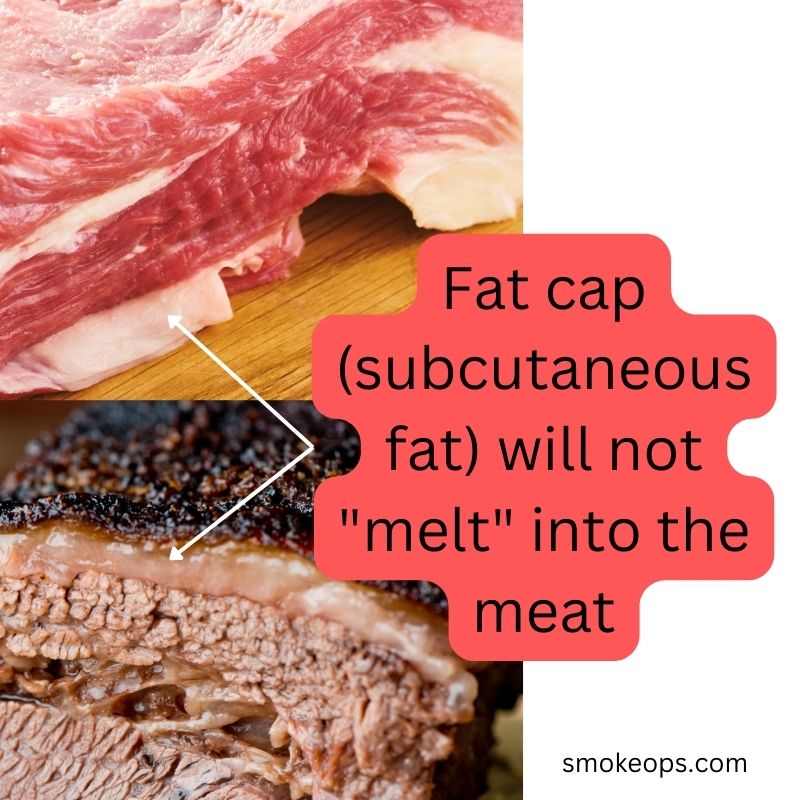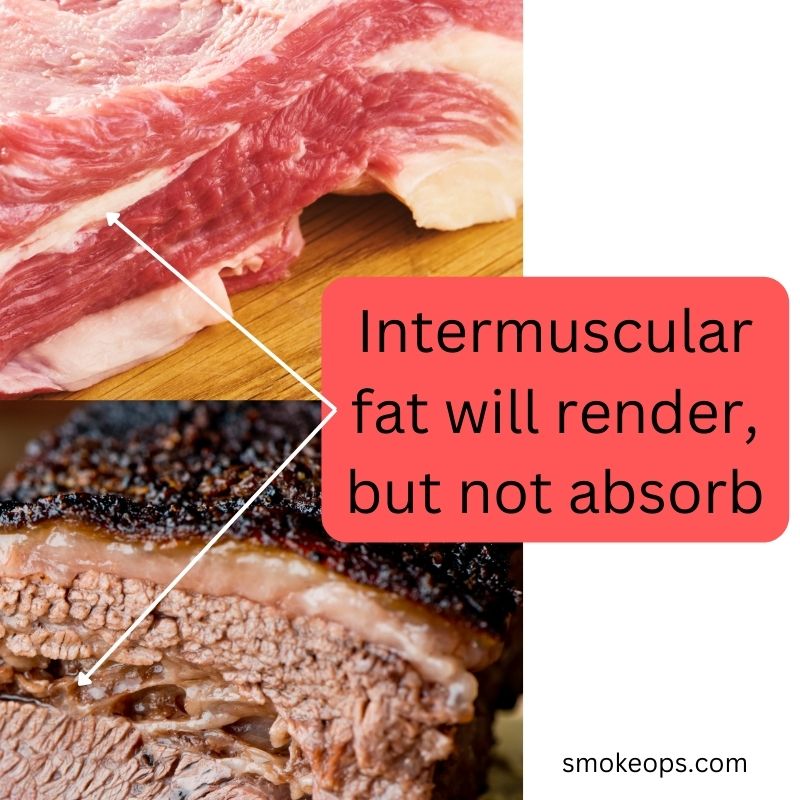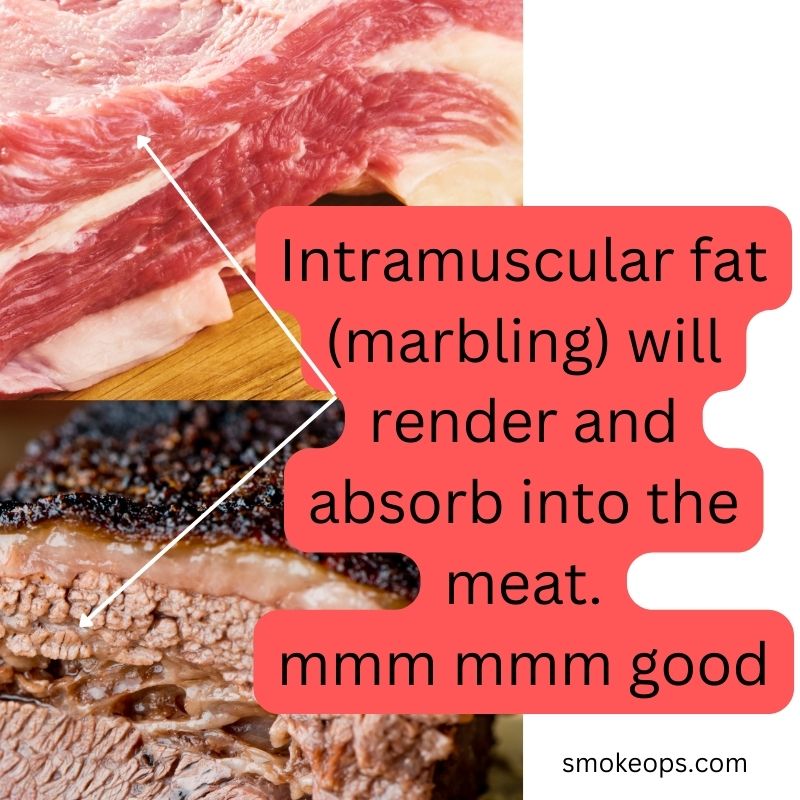Should we smoke brisket fat side up or down? This has been a hotly debated topic among grillmasters for years.
Some say that cooking the meat fat side up will help render the fat, resulting in a juicier, more flavorful piece of meat.
Others say that cooking the brisket fat side down will protect the meat from drying out. So, which method is the right one? Let’s look at the pros and cons of each approach to see which is best.
There was a time when I fell into the “fat side up” crowd, but then “I learnt some chemistry.”
TL:DR: I smoke brisket fat side down. Read on for why.
Fat Side Up
The case for cooking brisket fat side up is that the fat will render as the meat cooks, basting the brisket and keeping it moist.
Additionally, many believe that cooking the brisket like this allows the juices to flow down into the leaner portions of the meat, producing a more flavorful final product.
This is somewhat along the lines of spritzing or spraying your brisket while smoking to give flavor and keep it from drying out.
Proponents of fat side-up will say it prevents the formation of a crust on the underside of the brisket.
Fat Side Down
On the other side of the debate are those who believe that cooking brisket fat side down is the way to go.
The argument here is that placing the fat side down creates a barrier between the heat source and the meat, preventing it from drying out.
This makes sense to me as the idea is to cook the meat via indirect heat, which is what your smoker should be full of!
If the brisket is too close to the heat source (big brisket, small smoker, etc.), then having the fat side down closer to that heat source will protect the meat.
The biggest advantage of cooking fat side down is that your rub won’t be washed away by the dissolving fat if the fat were on top. To me, this is the deciding factor.
Smoke Science time
To really understand what’s going on, we have to understand the different types of fat you’ll see on your brisket and how those fats interact with the lean muscle you’ll eventually be eating.
The types of fat you need to think of are the fat you see on the top of the brisket, typically called the “fat cap“.
Then there are the thick slabs of fat between different lean muscles. These are intermuscular fats.
Then there is the marbling or the very thin lines of fat within the lean muscle itself, which is called intramuscular fat. These last thin lines of fat are what we need to render and “melt” during cooking. The other two are less important.
A closer look at how subcutaneous fat, or fat cap, affects your brisket

There is a science to consider when wondering about why that fat cap doesn’t “melt” into the meat or muscle of the brisket.
But it tastes wonderful (to me).
Some folks don’t like the taste and prefer to trim this down to nothing before smoking.
In a super simple sense, think of fat as oil and that lean muscle is made of proteins and mostly water. Oil and water don’t mix. During cooking, this water is evaporated from the meat in very small amounts regardless of what we do.
If water is coming out, there’s no way for the fatty oil to get in.
It can’t swim upstream.
How intermuscular fat affects your brisket

The thick layers of fat between the lean muscle of the brisket will break down and render during the smoking time. However, silver linings around these little fat packs will also prevent the fatty oils from being absorbed into the meat. It happens but in smaller amounts.
This “intermuscular” fat won’t add much flavor to the meat but does contribute to its overall texture.
Personally, I love this part of the brisket!
How does intramuscular fat, or marbling, affect your brisket?

The intermuscular fat is what is often called marbling and is the target of the long brisket smoking time.
We want those little strands to completely break down and render while smoking.
We smoke briskets “low and slow” to give these little guys ample time to fully render.
Cooking at 225-250(F) for long enough until the brisket itself hits around 195-203(F) is what we are shooting for.
Unless you are an expert, you should use a meat thermometer to ensure you don’t overcook.
We have a couple of articles that can help, one outlines my efforts at cooking brisket without a meat thermometer (fail!), and another shows you how to probe your brisket with a meat thermometer.
This is where much of the taste and texture comes from with a well-prepared and cooked brisket.
To better understand how fats affect the taste of your meat, spend some time with “The Role of Fat in the Palatability of Beef, Pork, and Lamb“.
So what’s the right answer?
My stance is that cooking brisket fat side down is the way to go. Here are my not-so-humble thoughts:
- The theory that having the fat on top of the brisket will allow the rendered and melted fat to baste and flavor the brisket doesn’t hold up to science. That fatty oil cannot penetrate if water is evaporating (and water is evaporating!)
- Having the fat between the source of the heat and the meat, even with indirect heat, prevents the meat from drying out. Smoking a brisket is a long process, so having that layer of fat acts as a heat shield and helps prevent the meat from drying out as much.
- An important point here is that if your heat source is above the meat, this all turns around (literally). Aaron Franklin, smoking guru, cooks with top heat and so cooks his briskets fat side up. He’s pretty good at this brisket thing, so I tend to take his word as gospel.
- If cooking your brisket fat side down, the rendered fat will not wash over the brisket during cooking, so your rubs will stay in place for the duration of the cook.
- If cooking fat side up, where do you add your rubs and spices? The spices you add will penetrate, at most, about a quarter of an inch during cooking, so adding spices or rubs to the fat cap makes no sense. So you are left with adding rubs and spices to the sides and bottom, which stand a good chance of being washed off by the melting fat during the smoking process.
- Trimming the fat to about a quarter inch and smoking it fat side down creates a delicious crust, or bark, that most brisket lovers…love.
A few thoughts about smoking other types of meat
Brisket is the end-all, be-all of the smoking world.
Get a brisket right, and it’s something to be proud of, and you’ll look forward to doing it again.
So will your friends and family. But there are other meats to smoke, so don’t limit yourself.
- Smoked pork
- Smoked turkey
- Smoked liver (yep, you read that right!)
- Smoked prime rib (one of my personal favorites)
And, of course, check this article for a list of good, cheap meats to smoke.
Should we smoke brisket fat side up or down – conclusion
Well, I hope we helped a bit with the often-asked question about whether we should smoke brisket fat side up or down.
My preference, and what you’ll see most other experts doing, is cooking their brisket fat side down for the reasons stated above.
Happy smoking!
